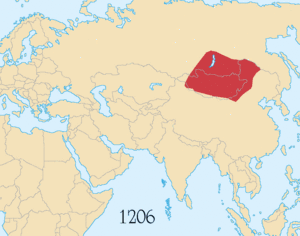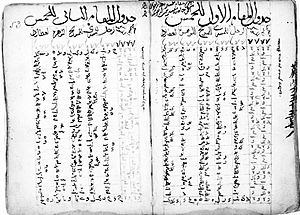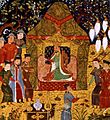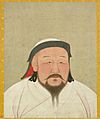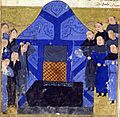Mongol Empire facts for kids
The Mongol Empire, an area ruled by the great Mongol Khans in the 13th and 14th centuries, was the largest contiguous land empire in history. The original homeland of the Mongols, was bounded by the Khingan Mountains on the east, the Altai and Tian mountains on the west, the Shilka River and the mountain ranges by Lake Baikal on the north, and the Great Wall of China on the south.
It was founded by Genghis Khan in 1206 AD when he brought together the Mongol and Turkic tribes. When he died in 1227 AD, he had conquered Central Asia, North China and parts of eastern Persia. Later his grandson Kublai Khan would go on to expand the empire and found the Mongol-ruled Yuan Dynasty, ruling whole China. The Mongol Empire stretched from Eastern Europe to Western Asia, including Central Asia and the Middle East. Its power did not last long, though. By the 1360s it had broken into several empires, all of which were later destroyed.
Contents
Science
The Mongol Empire saw some significant developments in science due to the patronage of the Khans. Roger Bacon attributed the success of the Mongols as world conquerors principally to their devotion to mathematics. Astronomy was one branch of science that the Khans took a personal interest in. According to the Yuanshi, Ögedei Khan twice ordered the armillary sphere of Zhongdu to be repaired (in 1233 and 1236) and also ordered in 1234 the revision and adoption of the Damingli calendar. He built a Confucian temple for Yelü Chucai in Karakorum around 1236 where Yelü Chucai created and regulated a calendar on the Chinese model. Möngke Khan was noted by Rashid al-Din as having solved some of the difficult problems of Euclidean geometry on his own and written to his brother Hulagu Khan to send him the astronomer Tusi. Möngke Khan's desire to have Tusi build him an observatory in Karakorum did not reach fruition as the Khan died on campaign in southern China. Hulagu Khan instead gave Tusi a grant to build the Maragheh Observatory in Persia in 1259 and ordered him to prepare astronomical tables for him in 12 years, despite Tusi asking for 30 years. Tusi successfully produced the Ilkhanic Tables in 12 years, produced a revised edition of Euclid's elements and taught the innovative mathematical device called the Tusi couple. The Maragheh Observatory held around 400,000 books salvaged by Tusi from the siege of Baghdad and other cities. Chinese astronomers brought by Hulagu Khan worked there as well.
Kublai Khan built a number of large observatories in China and his libraries included the Wu-hu-lie-ti (Euclid) brought by Muslim mathematicians. Zhu Shijie and Guo Shoujing were notable mathematicians in Yuan China. The Mongol physician Hu Sihui described the importance of a healthy diet in a 1330 medical treatise.
Ghazan Khan, able to understand four languages including Latin, built the Tabriz Observatory in 1295. The Byzantine Greek astronomer Gregory Chioniades studied there under Ajall Shams al-Din Omar who had worked at Maragheh under Tusi. Chioniades played an important role in transmitting several innovations from the Islamic world to Europe. These include the introduction of the universal latitude-independent astrolabe to Europe and a Greek description of the Tusi-couple, which would later have an influence on Copernican heliocentrism. Choniades also translated several Zij treatises into Greek, including the Persian Zij-i Ilkhani by al-Tusi and the Maragheh observatory. The Byzantine-Mongol alliance and the fact that the Empire of Trebizond was an Ilkhanate vassal facilitated Choniades' movements between Constantinople, Trebizond and Tabriz. Prince Radna, the Mongol viceroy of Tibet based in Gansu province, patronized the Samarkandi astronomer al-Sanjufini. The Arabic astronomical handbook dedicated by al-Sanjufini to Prince Radna, a descendant of Kublai Khan, was completed in 1363. It is notable for having Middle Mongolian glosses on its margins.
Mail system
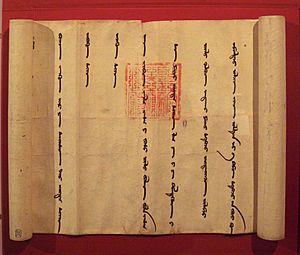
The Mongol Empire had an ingenious and efficient mail system for the time, often referred to by scholars as the Yam. It had lavishly furnished and well-guarded relay posts known as örtöö set up throughout the Empire. A messenger would typically travel 40 kilometres (25 miles) from one station to the next, either receiving a fresh, rested horse, or relaying the mail to the next rider to ensure the speediest possible delivery. The Mongol riders regularly covered 200 km (125 mi) per day, better than the fastest record set by the Pony Express some 600 years later. The relay stations had attached households to service them. Anyone with a paiza was allowed to stop there for re-mounts and specified rations, while those carrying military identities used the Yam even without a paiza. Many merchants, messengers, and travelers from China, the Middle East, and Europe used the system. When the great khan died in Karakorum, news reached the Mongol forces under Batu Khan in Central Europe within 4–6 weeks thanks to the Yam.
Genghis and his successor Ögedei built a wide system of roads, one of which carved through the Altai mountains. After his enthronement, Ögedei further expanded the road system, ordering the Chagatai Khanate and Golden Horde to link up roads in western parts of the Mongol Empire.
Kublai Khan, founder of the Yuan dynasty, built special relays for high officials, as well as ordinary relays, that had hostels. During Kublai's reign, the Yuan communication system consisted of some 1,400 postal stations, which used 50,000 horses, 8,400 oxen, 6,700 mules, 4,000 carts, and 6,000 boats.
In Manchuria and southern Siberia, the Mongols still used dogsled relays for the Yam. In the Ilkhanate, Ghazan restored the declining relay system in the Middle East on a restricted scale. He constructed some hostels and decreed that only imperial envoys could receive a stipend. The Jochids of the Golden Horde financed their relay system by a special Yam tax.
Silk Road
The Mongols had a history of supporting merchants and trade. Genghis Khan had encouraged foreign merchants early in his career, even before uniting the Mongols. Merchants provided information about neighboring cultures, served as diplomats and official traders for the Mongols, and were essential for many goods, since the Mongols produced little of their own.
Mongol government and elites provided capital for merchants and sent them far afield, in an ortoq (merchant partner) arrangement. In Mongol times, the contractual features of a Mongol-ortoq partnership closely resembled that of qirad and commenda arrangements, however, Mongol investors were not constrained using uncoined precious metals and tradable goods for partnership investments and primarily financed money-lending and trade activities. Moreover, Mongol elites formed trade partnerships with merchants from Italian cities, including Marco Polo’s family. As the empire grew, any merchants or ambassadors with proper documentation and authorization received protection and sanctuary as they traveled through Mongol realms. Well-traveled and relatively well-maintained roads linked lands from the Mediterranean basin to China, greatly increasing overland trade and resulting in some dramatic stories of those who travelled through what would become known as the Silk Road.
Western explorer Marco Polo traveled east along the Silk Road, and the Chinese Mongol monk Rabban Bar Sauma made a comparably epic journey along the route, venturing from his home of Khanbaliq (Beijing) as far as Europe. European missionaries, such as William of Rubruck, also traveled to the Mongol court to convert believers to their cause, or went as papal envoys to correspond with Mongol rulers in an attempt to secure a Franco-Mongol alliance. It was rare, however, for anyone to journey the full length of Silk Road. Instead, merchants moved products like a bucket brigade, goods being traded from one middleman to another, moving from China all the way to the West; the goods moved over such long distances fetched extravagant prices.
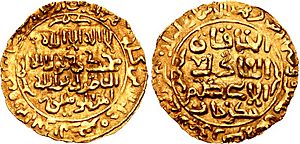
After Genghis, the merchant partner business continued to flourish under his successors Ögedei and Güyük. Merchants brought clothing, food, information, and other provisions to the imperial palaces, and in return the great khans gave the merchants tax exemptions and allowed them to use the official relay stations of the Mongol Empire. Merchants also served as tax farmers in China, Rus and Iran. If the merchants were attacked by bandits, losses were made up from the imperial treasury.
Policies changed under the Great Khan Möngke. Because of money laundering and overtaxing, he attempted to limit abuses and sent imperial investigators to supervise the ortoq businesses. He decreed that all merchants must pay commercial and property taxes, and he paid off all drafts drawn by high-ranking Mongol elites from the merchants. This policy continued under the Yuan dynasty.
The fall of the Mongol Empire in the 14th century led to the collapse of the political, cultural, and economic unity along the Silk Road. Turkic tribes seized the western end of the route from the Byzantine Empire, sowing the seeds of a Turkic culture that would later crystallize into the Ottoman Empire under the Sunni faith. In the East, the Han Chinese overthrew the Yuan dynasty in 1368, launching their own Ming dynasty and pursuing a policy of economic isolationism.
Legacy
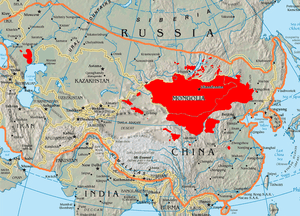
The Mongol Empire, at its height of the largest contiguous empire in history, had a lasting impact, unifying large regions. Some of these (such as eastern and western Russia, and the western parts of China) remain unified today. Mongols might have been assimilated into local populations after the fall of the empire, and some of their descendants adopted local religions. For example, the eastern khanate largely adopted Buddhism, and the three western khanates adopted Islam, largely under Sufi influence.
According to some interpretations, Genghis Khan's conquests caused wholesale destruction on an unprecedented scale in certain geographic regions, leading to changes in the demographics of Asia.
The non-military achievements of the Mongol Empire include the introduction of a writing system, a Mongol alphabet based on the characters of the Old Uyghur, which is still used in Mongolia today.
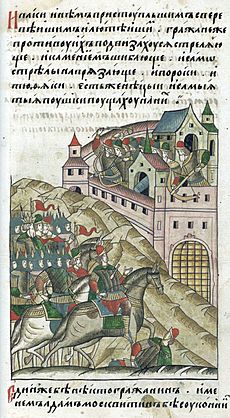
Some of the other long-term consequences of the Mongol Empire include:
- Moscow rose to prominence while it was still under the rule of the Mongol-Tatar yoke, some time after Russian rulers were accorded the status of tax collectors for the Mongols. The fact that the Russians collected tribute and taxes for the Mongols meant that the Mongols themselves rarely visited the lands which they owned. The Russians eventually gained military power, and their ruler Ivan III completely overthrew the Mongols and formed the Russian Tsardom. After the Great Stand on the Ugra River proved that the Mongols were vulnerable, the Grand Duchy of Moscow gained independence.
- Europe's knowledge of the known world was immensely expanded by the information which was brought back to it by ambassadors and merchants. When Columbus sailed in 1492, his mission was to reach Cathay, the land of the Grand Khan in China, and give him a letter from the monarchs Ferdinand II of Aragon and Isabella I of Castile.
- Some studies indicate that the Black Death which devastated Europe in the late 1340s may have traveled from China to Europe along the trade routes of the Mongol Empire. The total number of deaths worldwide from the pandemic is estimated at 75–200 million with up to 50 million deaths in Europe alone.
- Western researcher R. J. Rummel estimated that 30 million people were killed by the Mongol Empire. Other researchers estimate that as many as 80 million people were killed, with 50 million deaths being the middle ground. The population of China fell by half during fifty years of Mongol rule. Before the Mongol invasion, the territories of the Chinese dynasties reportedly had approximately 120 million inhabitants; after the conquest was completed in 1279, the 1300 census reported that China's total population was roughly 60 million. While it is tempting to attribute this major decline in China's population solely to Mongol ferocity, today scholars have mixed opinions about this subject. Scholars such as Frederick W. Mote argue that the wide drop in numbers reflects an administrative failure to keep records rather than a de facto decrease, while others such as Timothy Brook argue that the Mongols reduced much of the south Chinese population, and very debatably the Han Chinese population, to an invisible status through cancellation of the right to passports and denial of the right to direct land ownership. This meant that the Chinese had to depend on and be cared for chiefly by Mongols and Tartars, which also involved recruitment into the Mongol army. Other historians such as William McNeill and David O. Morgan argue that the bubonic plague was the main factor behind China's demographic decline during this period.
- The Islamic world was subjected to massive changes as a result of the Mongol invasions. The population of the Iranian plateau suffered from widespread disease and famine, resulting in the death of up to three-quarters of its population, possibly 10 to 15 million people. Historian Steven Ward estimates that Iran's population did not reach its pre-Mongol levels again until the mid-20th century.
- Mesopotamia, for millennia a showplace and pinnacle of human civilization and achievement, was depopulated and pastoralized, never to resume its previous pre-eminence.
Images for kids
-
Mongol tribes during the Khitan Liao dynasty (907–1125)
-
The Old World on the eve of the Mongol invasions, c. 1200
-
Genghis Khan ascended the throne in the Ikh Khuraldai region in the Onan river, from the Jami' al-tawarikh.
-
Coronation of Ögedei Khan in 1229 as the successor of Genghis Khan. By Rashid al-Din, early 14th century.
-
Batu Khan consolidates the Golden Horde
-
Güyük Khan demanding Pope Innocent IV's submission. The 1246 letter was written in Persian.
-
Hulagu, Genghis Khan's grandson and founder of the Il-Khanate. From a medieval Persian manuscript.
-
The extent of the Mongol Empire after the death of Möngke Khan (reigned 1251–1259).
-
Kublai Khan, Genghis Khan's grandson and founder of the Yuan dynasty
-
The samurai Suenaga facing Mongol's bomb and Goryeo's arrows. Mōko Shūrai Ekotoba (蒙古襲来絵詞), circa 1293.
-
The funeral of Chagatai Khan.
-
Mongol rider, Yuan dynasty
-
Hungarian King Béla IV in flight from the Mongols under general Kadan of the Golden Horde.
-
The Battle of Blue Waters in 1362, in which Lithuania successfully pushed the Golden Horde from the Principality of Kiev.
-
Mongol general Subutai of the Golden Horde
-
Persian miniature depicting Ghazan's conversion from Buddhism to Islam.
See also
 In Spanish: Imperio mongol para niños
In Spanish: Imperio mongol para niños


